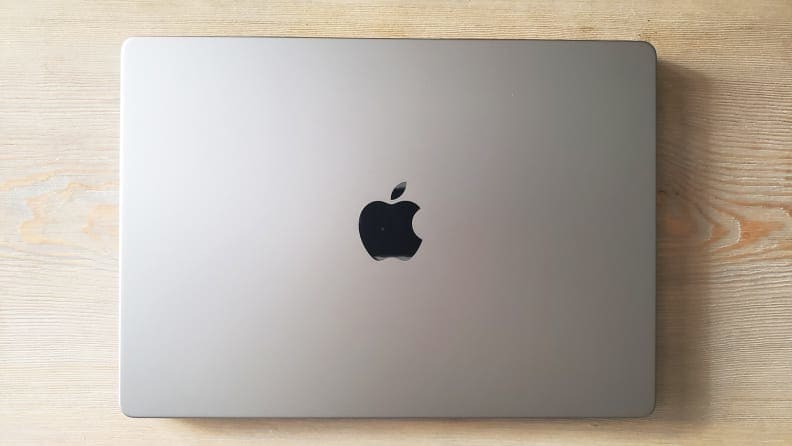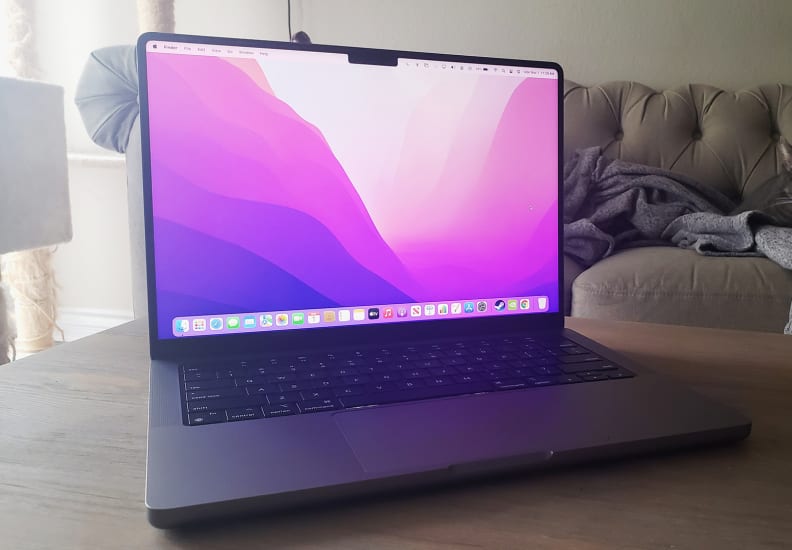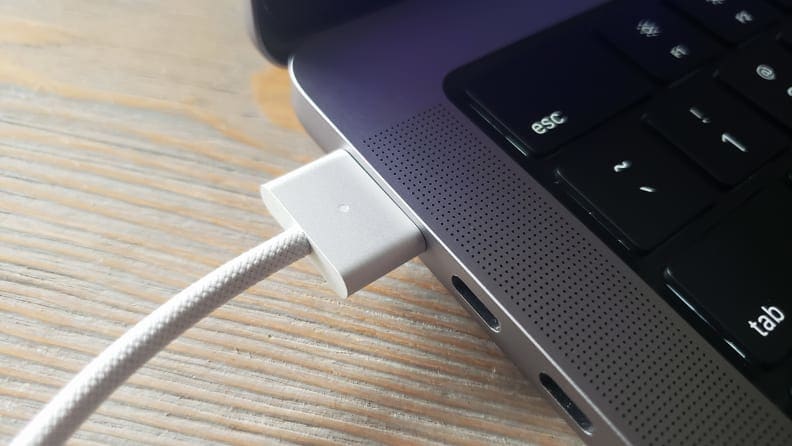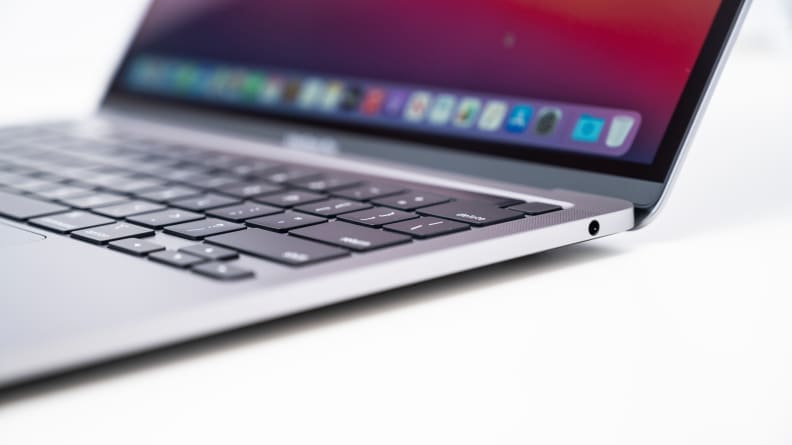MacBook Pro 13 vs. MacBook Pro 14: Which one is right for you?
Is the MacBook Pro 14 worth the upcharge? We'll help you decide.
 Credit:
Reviewed / Joanna Nelius
Credit:
Reviewed / Joanna Nelius
Products are chosen independently by our editors. Purchases made through our links may earn us a commission.
Apple is deep into its transition away from Intel-based Macs with its impressive Apple Silicon processors, and now that it has a total of three processors in its Apple Silicon line-up (M1, M1 Pro, and M1 Max), it can be a little hard to tell which laptop you need. Just how “pro” is the M1 Pro processor, and what exactly makes each product stand out if they have the same kinds of cores?
While the MacBook Pro 13 comes with the M1 processor, the MacBook Pro 14 comes with the M1 Pro or M1 Max processor. The M1 Pro focuses more on bandwidth and performance while the M1 focuses more on balance and battery life, but they are both very capable processors for the right person. We’re here to demystify how much more you’ll actually gain upgrading from the 13-inch to the 14-inch model.
Get the MacBook Pro 13 M1 at Best Buy for $1,299
Get the MacBook Pro 14 M1 Pro at Amazon for $1,999
Performance

The MacBook Pro 14's new M1 Pro processor builds on the foundations of the M1 to make a faster, more powerful chip.
Apple’s processors all have the same hybrid core design, meaning some cores are reserved for performance-driven tasks and others are reserved for efficient tasks. . Compared to the M1 processor, however, the M1 Pro has a slightly different design. The M1 processor in the base 13-inch MacBook Pro was designed with eight CPU cores (four high-power and four low-power cores) and eight GPU cores, while the M1 Pro processor in the base 14-inch MacBook Pro was designed with eight CPU cores (six high-power and two low-power) and 14 GPU cores.
The M1 and M1 Pro theoretically have the same CPU performance, but Apple’s change to the number of high-power and low-power cores in the M1 Pro gives it a slight edge over the M1. Simple tasks, like running Spotify and Google Chrome, will not benefit from the M1 Pro’s performance boost. However, in multicore performance, the M1 Pro gains a 31% boost over the M1 in Geekbench 5, a program we use to measure CPU performance. Anyone who needs to transcode 4K video or render 3D images faster should be pleased with how the M1 Pro performs in real-world, multicore tasks like those.
Compared to the MacBook Pro 13, the 14-inch laptop is a minute and 30 seconds faster than the M1 at encoding a 12-minute 4K video file to 1080p in Handbrake. The MacBook Pro 14 also has more memory bandwidth (200GB/s) than the MacBook Pro 13 (about 70GB/s, or “almost [1/6th] the bandwidth [of the M1 Max]” according to Apple, so scrubbing high-resolution video files will be smoother.

While the MacBook Pro 14 isn't aimed at gamers, we were impressed by how well it performs in this area.
On the GPU side, the MacBook Pro 13 has great integrated graphics performance, but it pales in comparison to what the MacBook Pro 14 can achieve. To render a 3D image in Blender, for instance, the MacBook Pro 13 takes a little over six minutes to do so with its eight GPU cores—but the MacBook Pro 14’s M1 Pro with 14 GPU cores renders the scene in a little under five and a half.
For gaming, the MacBook Pro 13’s modest graphics performance translates to a passable experience for less demanding 3D games, like Fortnite or Final Fantasy: XIV, where you could expect 30 to 45 frames per second at 1080p with medium graphics presets. The more demanding game Shadow of the Tomb Raider runs at 23 fps on the highest graphics presets. The MacBook Pro 14 fares much better: 43 fps on Shadow of the Tomb Raider’s highest graphics presets, which is about equal to an entry-level Nvidia graphics card like the GTX 1650.
Our pick: MacBook Pro 14
Battery life

The 2021 MacBooks bring back the MagSafe charger.
The MacBook Pro 13 has almost fourteen hours of battery life—even if you load up a bunch of apps, it will make it through your workday and your downtime. If you need a lot of battery life, this is the laptop to get, without question. In comparison, the MacBook Pro 14 has about ten and a half hours of battery life, which is still excellent but notably shorter than the MacBook Pro 13’s life.
Our pick: MacBook Pro 13
Upgrades

The MacBook Pro 13 has a Touchbar, but the MacBook Pro 14 has more ports.
The MacBook Pro 13 is configurable with 8GB or 16GB of RAM, which puts a limit on how many files and programs you can have open at the same time. This is enough for productivity and light video production, but if you are working with exceptionally memory-hungry applications, like Adobe After Effects or Autodesk Maya, the laptop can begin to strain.
The MacBook Pro 14 can come with 16GB or 32GB of RAM, which will do wonders for your laptop’s performance with high-bandwidth tasks. (If that’s still not enough, you can upgrade the MacBook Pro 14 to an M1 Max, which is Apple’s most powerful chip.)
Meanwhile, the 13-inch M1 MacBook Pro can come with anywhere from 256GB to 2TB of storage, depending on the configuration. If you want more than 2TB of storage, the MacBook Pro 14 supports up to 8TB of internal storage. The minimum you can get is 512GB.
Our pick: MacBook Pro 14
Features

Who needs ports these days? (Everyone, that's who. Give us ports!)
If you would prefer to work on a separate display, the MacBook Pro 14 has a lot more options than the MacBook Pro 13. The MacBook Pro 13 comes with two USB-C/Thunderbolt 4 ports and a headphone jack by default, which can only support up to one external 6K at 60Hz display. There is no dedicated charging port, so you’ll need to plug in through a Thunderbolt port.
The MacBook Pro 14 has a lot more ports: three USB-C/Thunderbolt 4 ports, an HDMI 2.0 port, an SDXC card reader, and a headphone jack. You can connect up to two 6K at 60Hz displays via Thunderbolt 4 with the M1 Pro, although note the HDMI port only supports 4K at 60Hz.
The MacBook Pro 14 also brings back a dedicated MagSafe charging port and a physical full-size function key row instead of the MacBook Pro 13’s Touchbar. The webcam gets an upgrade to 1080p (yes, the MacBook Pro 13 is still using a 720p webcam in 2021), and the bezels are thinner than ever thanks to the top notch design that carves out screen space around the webcam. The trackpad and keyboard on both MacBooks are virtually identical—although we noted the MacBook Pro 14’s trackpad was rougher than the MacBook Pro 13’s.
If you need the best display possible, the MacBook Pro 14 is a step up from the 13-inch model. It has a 120Hz, mini-LED 3024 x 1964p display with an adaptive refresh rate. Meanwhile, the MacBook Pro 13 has a 60Hz LED 2560 x 1600p display. While the 13-inch model has up to 500 nits and the 14-inch model has up to 1000 nits of sustained brightness, you won't see that brightness on your screen unless you are working with HDR content. Otherwise, in our testing, we found that the MacBook Pro 14 only reached a max of 410 brightness, which is about as bright as the MacBook Pro 13.
Our pick: MacBook Pro 14
Price and value

While the MacBook Pro 14 offers more features, the MacBook Pro 13 is a lot cheaper and still very, very good.
If the MacBook Pro 14 were two, maybe three hundred dollars more expensive than the MacBook Pro 13, we wouldn’t hesitate to recommend splurging on a MacBook Pro 14. However, the cheapest MacBook Pro 14 retails for $1,999—almost twice as much as the cheapest MacBook Pro 13 which retails for $1,299, although we’ve seen it as low as $1,099.99 on sale at retailers like Amazon and Best Buy.
The MacBook Pro 14 is aimed at professionals who’d rather save time than money, and its price reflects that. Most of us won’t really benefit from the MacBook Pro 14’s extra features (like its ProRes-compatible media engine, which is mostly helpful for just film folk), so it wouldn’t be worth the upcharge.
Our pick: MacBook Pro 13
And the winner is…

The MacBook Pro 13 is powerful enough for most people, but the MacBook Pro 14 is incredible for those that need the upgrade.
If you’re a content creator or a design student, the MacBook Pro 14 is an excellent upgrade from the MacBook Pro 13. It’s notably faster for video work in particular thanks to the dedicated ProRes media engine, has double the graphics performance over the MacBook Pro 13, and has 30% more multicore CPU performance. It can support one more external 6K display than the MacBook Pro 13, comes with up to 32GB of memory and 8TB of internal storage, and it still has over ten hours of battery life. It’s also notably more expensive than the MacBook Pro 13, with the cheapest 14-inch model starting at $1,999.
However, if you need a laptop for everyday productivity, you will probably be just as pleased with a MacBook Pro 13, which retails as low as $1,099. The processors perform as well as Intel’s and AMD’s best mobile processors, so you’re not missing out over its Windows competitors. The MacBook Pro 13 has an incredible fourteen-hour battery life, and it has enough graphics power to run mildly demanding games at playable frame rates.
Both laptops are incredible machines perfect for demanding users, so the better laptop for you ultimately depends on your workload. If you need a boatload of RAM, desktop-like graphics power, and snappy video encoding, then the extra cost for the MacBook Pro 14 will be worth it. On the other hand, if you need a daily driver that can handle some Photoshopping and casual gaming, then save hundreds of dollars and get a MacBook Pro 13.
If you only need a laptop for light to moderate productivity tasks, then a base MacBook Air is also worth considering. We break down the differences between the MacBook Air and MacBook Pro 13 here. If you’re worried the MacBook Pro 14 can’t keep up with your needs, then the MacBook Pro 14 with an M1 Max processor or the MacBook Pro 16 could be for you. Look out for more MackBook Pro coverage from us in the next few weeks.
Get the MacBook Pro 14 for $1,999 Get the MacBook Pro 13 for $1,299


